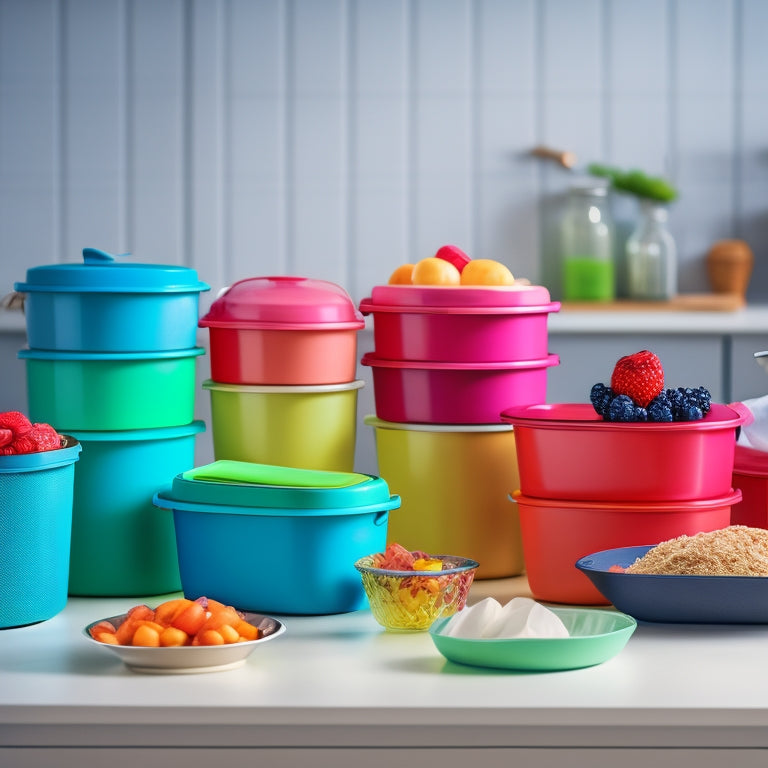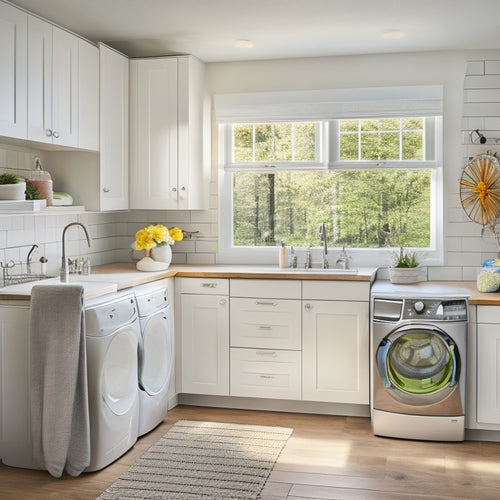
Master the Art of Organizing Food Containers
Share
I've mastered the art of organizing my food containers, and it's transformed my kitchen into a haven of efficiency and productivity. By implementing a labeling system, regular cleaning, and decluttering, I've reduced food waste, saved time, and maximized storage space. I've also set aside time for maintenance, decluttering unused containers, and reorganizing monthly. My containers are now easily accessible, and I can quickly identify their contents. With a few simple strategies, I've taken my kitchen organization to the next level - and you can too by exploring the simple yet effective techniques that have worked wonders for me.
Key Takeaways
• Implement a labeling system to quickly identify contents and reduce food waste.
• Establish a regular cleaning routine to maintain a hygienic and organized container collection.
• Declutter unused containers and adopt the 'one in, one out' rule to prevent clutter buildup.
• Utilize a combination of storage solutions, such as drawer dividers and clear bins, to maximize cupboard space.
• Set aside time for regular maintenance to ensure containers remain organized and easily accessible.
Benefits of Food Container Organization
By organizing my food storage containers, I've noticed a significant reduction in food waste and saved time searching for containers, which has ultimately maximized my storage space and improved my overall kitchen organization.
I'm no longer rummaging through my cupboard, only to find expired or spoiled food. By implementing a simple organization system, I've reduced waste and saved money on groceries. I've also gained valuable time, no longer spent searching for the right container or lid.
My kitchen now feels more organized, clutter-free, and peaceful. With these benefits, I'm motivated to maintain my organized space. By following these time-saving tips, you can experience the same benefits and enjoy a more efficient kitchen.
Organizing Food Containers Efficiently
To guarantee my food storage containers are organized efficiently, I've adopted a few simple strategies that have transformed the way I store and manage my kitchen essentials.
First, I implemented a container labeling system, which involves labeling each container with its contents and date. This helps me quickly identify what's inside and makes sure I use the oldest items first.
Next, I established a regular cleaning routine, where I wash and dry each container after use. This prevents the buildup of bacteria and keeps my containers in good condition.
I also make it a habit to declutter my containers regularly, getting rid of any that are no longer needed or are in poor condition.
Maintaining Your Container Collection
Regularly, I set aside time to maintain my container collection, ensuring it remains organized and clutter-free. This routine container maintenance is essential to preventing clutter buildup and keeping my kitchen organized.
I declutter unused containers, clean them after each use, and reorganize them monthly. I also check for damaged containers, replace worn-out ones, and implement a 'one in, one out' rule to maintain a balanced collection.
Additionally, I clean containers and lids before storing them, making sure they're dry and free of residue. By following these decluttering tips and cleaning and upkeep strategies, I can enjoy a stress-free kitchen and make the most of my container collection.
Storage Solutions for Food Containers
I've found that using a combination of storage solutions helps me maximize my cupboard space and keep my food containers organized. This allows me to easily find what I need and prevents clutter from building up.
To take my organization to the next level, I also use container labeling to identify contents and dates. Drawer dividers help separate containers and lids, while clear bins provide visibility and easy access.
Maximizing Cupboard Space Creatively
By thinking outside the box - or in this case, the cupboard - I've discovered creative ways to maximize my cupboard space, making the most of every inch.
One of my favorite DIY hacks is repurposing containers to create custom storage solutions. For instance, I've turned old mason jars into spice containers and used wooden crates to store infrequently used kitchen gadgets.
I've also utilized tension rods to create dividers in my drawers, keeping lids and containers organized and easy to access.
By thinking creatively, I've managed to squeeze every last bit of space out of my cupboard, making meal prep and cooking a breeze.
With a little imagination, you can do the same and transform your kitchen into a clutter-free haven.
Frequently Asked Questions
How Do I Prevent Containers From Becoming Scratched or Damaged?
When chaos reigns, my kitchen containers suffer; to prevent scratches and damage, I handle them with gentle care, using soft cloths to wipe them clean and storing them securely to make sure they remain in pristine condition.
Can I Use Food Storage Containers for Non-Food Items Too?
I repurpose food storage containers to store desk supplies like paper clips and pens, and even use them for craft storage, keeping my workspace organized and clutter-free while protecting my belongings from damage.
Are There Any Eco-Friendly Food Storage Container Options Available?
As I navigate the forest of disposable plastics, I'm on the hunt for eco-friendly allies. I discover sustainable materials and bioplastic alternatives, like bamboo and PLA, that help me store food while preserving the planet's harmony.
How Do I Keep Containers From Absorbing Food Odors and Flavors?
I prevent containers from absorbing food odors and flavors by washing them with soap and warm water, then drying thoroughly, and using odor-blocking products or flavor-neutralizing coatings to guarantee my containers stay fresh and clean.
Can I Sanitize Food Storage Containers in the Dishwasher?
'I'm on edge wondering if my dishwasher can sanitize my food storage containers. Thankfully, I can use the 'sanitize' or 'sterilize' cycle setting with hot water temperature (usually 140°F) to guarantee a bacteria-free clean, giving me peace of mind.'
Related Posts
-

Revamp Your Laundry Room With Smart Space-Saving
You're tired of feeling cramped and disorganized in your laundry room, and it's time to revamp the space to make the ...
-

Data Lakes and Warehouses: Unveiling Data Wisdom
Data lakes and warehouses are two distinct data storage solutions that serve different purposes. Data lakes store mas...

